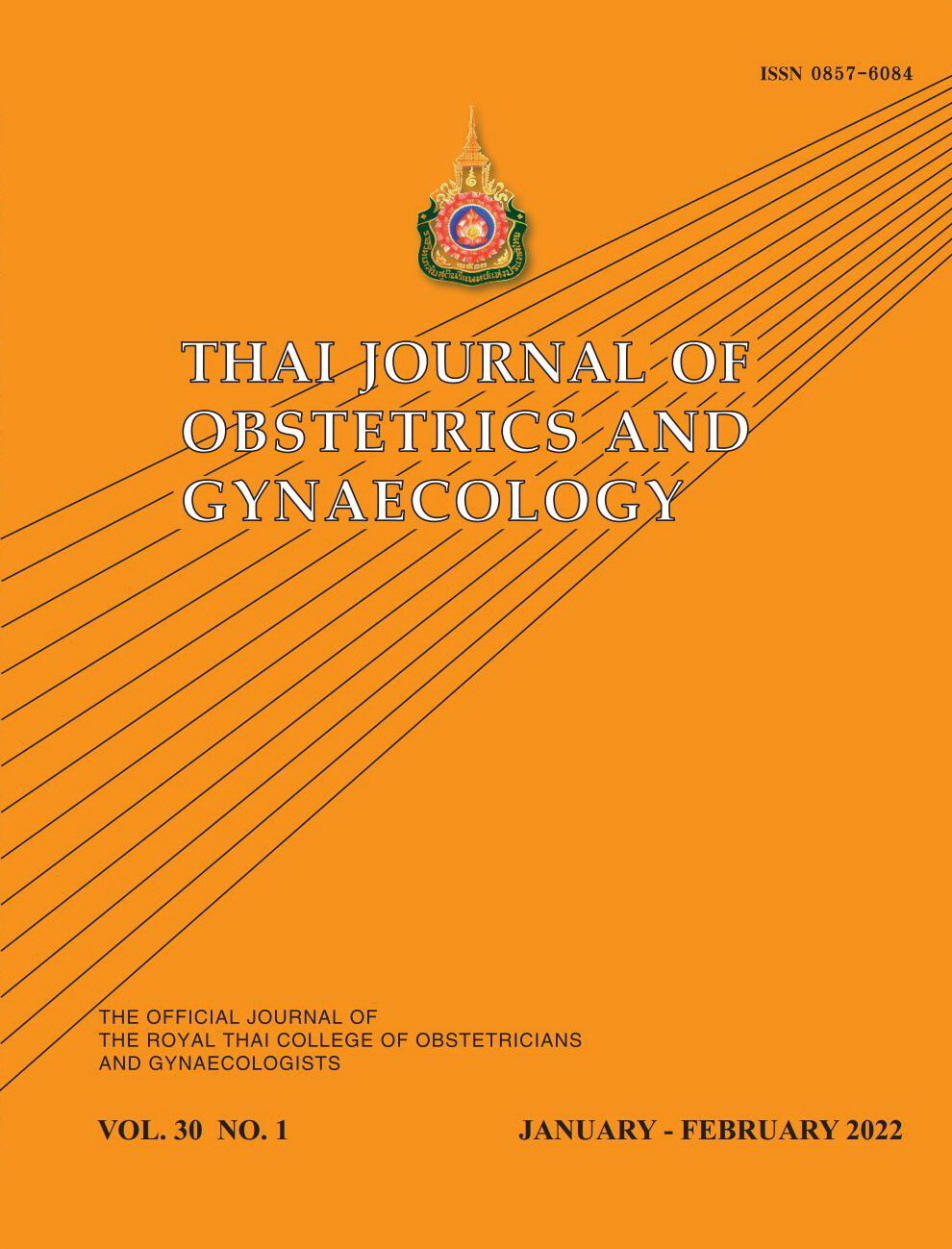Effects of Episioguide – a 60° Mediolateral Episiotomy Guide Device – on Post Suture Episiotomy Angle: A randomized controlled trial
Main Article Content
Abstract
Objectives: To compare the post-suture episiotomy angle between groups on which the Episioguide – a 60° mediolateral episiotomy (MLE) guide device was used and not used in the performance of MLE.
Materials and Methods: This prospective randomized controlled trial was conducted at the HRH Princess Maha Chakri Sirindhorn Medical Center, Nakhon Nayok, Thailand. Eligible women were randomized into two groups, the first group was women who had a MLE using the Episioguide and the second group was women who had a conventional MLE. The primary outcome was a comparison of the rates of post-suture episiotomy angle in the safe zone (30°-60°) between the groups.
Results: One-hundred and twelve eligible pregnant women were recruited, of whom 88 underwent randomization, 44 each in the Episioguide and conventional MLE groups. The procedures using the Episioguide had a significantly higher rate of a post-suture episiotomy angle in the desired 30°-60° range (relative risk (RR) 1.526, 95% confidence interval (CI) 1.023-2.277, p = 0.032), and there was a statistically significant difference in mean post suture angle between the two groups, 34.636° ± 9.445° in the Episioguide group and 27.614° ± 9.267° in the standard procedure group (mean difference 7.022, 95%CI 3.057-10.988, p = 0.001).
Conclusion: Using the Episioguide to perform a MLE achieved a significantly higher rate of post-suture episiotomy angle in the safe zone compared with conventional MLE.
Article Details

This work is licensed under a Creative Commons Attribution-NonCommercial-NoDerivatives 4.0 International License.
References
Cunningham FG, Leveno KJ, Bloom SL, Dashe JS, Hoffman BL, Casey BM, et al. Williams Obstetrics. 25th ed. New York: McGraw-Hill 2018.
Sooklim R, Thinkhamrop J, Lumbiganon P, Prasertcharoensuk W, Pattamadilok J, Seekorn K, et al. The outcomes of midline versus medio-lateral episiotomy. Reprod Health 2007;4:10.
Lewicky-Gaupp C, Leader-Cramer A, Johnson LL, Kenton K, Gossett DR. Wound complications after obstetric anal sphincter injuries. Obstet Gynecol 2015;125:1088-93.
ACOG Practice Bulletin No. 165: Prevention and Management of Obstetric Lacerations at Vaginal Delivery. Obstet Gynecol 2016;128:e1-e15.
Norderval S, Nsubuga D, Bjelke C, Frasunek J, Myklebust I, Vonen B. Anal incontinence after obstetric sphincter tears: incidence in a Norwegian county. Acta Obstet Gynecol Scand 2004;83:989-94.
Pereira GMV, Hosoume RS, de Castro Monteiro MV, Juliato CRT, Brito LGO. Selective episiotomy versus no episiotomy for severe perineal trauma: a systematic review with meta-analysis. Int Urogynecol J 2020;31: 2291-9.
WHO recommendations on intrapartum care for a positive childbirth experience 2018.
Drusany Staric K, Lukanovic A, Petrocnik P, Zacesta V, Cescon C, Lucovnik M. Impact of mediolateral episiotomy on incidence of obstetrical anal sphincter injury diagnosed by endoanal ultrasound. Midwifery 2017;51:40-3.
Stedenfeldt M, Pirhonen J, Blix E, Wilsgaard T, Vonen B, Øian P. Episiotomy characteristics and risks for obstetric anal sphincter injuries: a case-control study. BJOG 2012;119:724-30.
Kalis V, Landsmanova J, Bednarova B, Karbanova J, Laine K, Rokyta Z. Evaluation of the incision angle of mediolateral episiotomy at 60 degrees. Int J Gynaecol Obstet 2011;112:220-4.
Naidu M, Kapoor DS, Evans S, Vinayakarao L, Thakar R, Sultan AH. Cutting an episiotomy at 60 degrees: how good are we? Int Urogynecol J 2015;26:813-6.
Sawant G, Kumar D. Randomized trial comparing episiotomies with Braun-Stadler episiotomy scissors and EPISCISSORS-60(®). Med Devices (Auckl) 2015;8: 251-4.
van Roon Y, Kirwin C, Rahman N, Vinayakarao L, Melson L, Kester N, et al. Comparison of obstetric anal sphincter injuries in nulliparous women before and after introduction of the EPISCISSORS-60(®) at two hospitals in the United Kingdom. Int J Womens Health 2015;7:949-55.
van Roon Y, Vinayakarao L, Melson L, Percival R, Pathak S, Pradhan A. Comparative study of episiotomy angles achieved by cutting with straight Mayo scissors and the EPISCISSORS-60 in a birth simulation model. Int Urogynecol J 2017;28:1063-6.
Koh LM, van Roon Y, Pradhan A, Pathak S. Impact of the EPISCISSORS-60 mediolateral episiotomy scissors on obstetric anal sphincter injuries: a 2-year data review in the United Kingdom. Int Urogynecol J 2020;31:1729-34.
Divakova O, Khunda A, Ballard PA. Episcissors-60™ and obstetrics anal sphincter injury: a systematic review and meta-analysis. Int Urogynecol J 2020;31:605-12.
Freeman R, Hollands H, Barron L, Kapoor D. Cutting a mediolateral episiotomy at the correct angle: evaluation of a new device, the Episcissors-60. Med Devices (Auckl) 2014;7:23-8.


